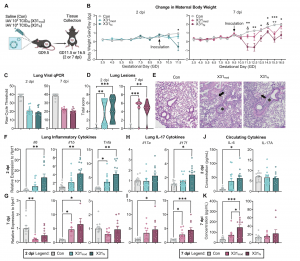A growing body of evidence suggests a correlation between severe maternal influenza and an increased risk of neurodevelopmental disorders in offspring, such as schizophrenia and autism spectrum disorder. However, the precise mechanisms underlying this association remain elusive.
Recent research has shed new light on this complex issue by employing a more biologically relevant model of influenza infection in pregnant mice (Figure 1). Unlike previous studies that utilized viral mimics, this study employed live influenza A virus, allowing for a more accurate representation of human influenza pathogenesis.

Figure 1: Respiratory IAV infection alters maternal lung inflammation and circulating cytokines in a dose- and time-dependent manner. A Experimental schematic. B IAV inoculation at GD9.5 suppressed body weight gain per day from 2-to-7 dpi in X31 hi dams only (repeated measures 2-way ANOVA, the main effect of time = p < 0.001; * = Con vs X31 hi , & = X31 mod vs X31 hi , + = Con vs X31 mod ). C The presence of IAV-X31 in lungs at 2 and 7 dpi was evaluated using qPCR with a cycle threshold of ≤ 30 cycles as confirmed infection (dotted line). D Quantification of H&E pathological scoring showed elevated lung lesion scores in infected dams. The scoring criteria are listed in the methods with additional scoring values in Supplementary Table S3. E Representative photomicrographs of H&E-stained lung sections. Asterisks (*) indicate bronchi filled with clusters of neutrophils with cellular debris, and arrows (→) indicate arterial and venous endothelia with rolling neutrophils. Genes encoding for classic pro-inflammatory cytokines IL-6, IL-1β, and TNF-α in maternal lungs were F upregulated in a dose-dependent manner at 2 dpi whereas G only Il1b was upregulated at 7 dpi. IL-17 genes were upregulated in the maternal lung at H 2 and I 7 dpi in a dose-dependent manner. Maternal cytokines in circulation at J 2 and K 7 dpi. Pro-inflammatory cytokine IL-6 was upregulated in moderate- and high-dose dams proportional to dosage at both time points. IL-17A was not upregulated in circulation at either endpoint. IAV = influenza A virus, GD = gestational day, dpi = days post-inoculation, Con = saline control, X31 mod = IAV-X31 10 3 TCID50 , X31 hi = IAV-X31 104 TCID 50 . Groups were compared using one-way ANOVA with Tukey post hoc for multiple comparisons. For data containing residuals with unequal variance, Brown-Forsythe and Welch’s ANOVA with Dunnett T3 post hoc multiple comparisons was used. For non-parametric data, Kruskal–Wallis ANOVA with Dunn’s correction for multiple comparisons was used. Data are means ± SEM; one symbol = p < 0.05, two symbols = p < 0.01, three symbols = p < 0.001; dots represent individual dams; n = 9–14 per treatment group. See Supplementary Tables S3–5 for complete statistical analysis of all data collected for this figure (individual mean ± SEM per group, p-values, hypothesis test used, and test statistic).
Key findings include a dose-dependent effect of maternal infection on fetal brain development, with more severe infections leading to pronounced alterations in cortical structure. These changes bear striking resemblance to those observed in postmortem studies of individuals with neurodevelopmental disorders.
While previous research implicated interleukin-17 as a crucial mediator of fetal brain abnormalities, this study found no elevation of this cytokine in infected mothers. Instead, the focus shifted towards the role of microglia and fetal border-associated macrophages (BAMs) in mediating neuroinflammation. These innate immune cells, essential for normal brain development, may become dysregulated in response to severe maternal infection, potentially leading to neurodevelopmental impairments.
It is important to emphasize that maternal influenza is one of several factors contributing to the development of neurodevelopmental disorders. A comprehensive understanding of these complex interactions requires further investigation into genetic, environmental, and postnatal influences.
Nevertheless, the current findings underscore the importance of influenza vaccination during pregnancy as a preventive measure to reduce the risk of severe maternal infection and its potential consequences for fetal brain development.
Journal article: Otero, A.M., et al., 2024. Influenza A virus during pregnancy disrupts maternal intestinal immunity and fetal cortical development in a dose- and time-dependent manner. Molecular Psychiatry.
Summary by Stefan Botha










